Ark Clams - Blood Clams
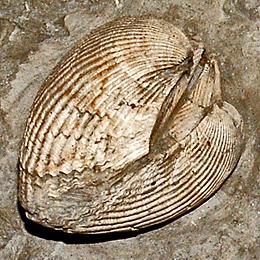 [Ark Shell; family Arcidae]
[Ark Shell; family Arcidae]
Found worldwide, Ark Clams are generally small, mostly 1 to 2 inches,
but a few get tp 5 inches. Among the Ark Clams are the only shellfish
that have red blood pigments (hemoglobin and myoglobin). This gives
them better oxygen transfer allowing them to live in murky low oxygen
environments in which most predators cannot thrive. These clams first
appeared in the early Cretaceous, about 140 milion years ago. The fossil
in the photo is of Anadara diluvii, which appeared about 23
milion years ago and went extinct only about 12,000 years ago, at
the end of the last ice age.
Photo by Hectonichus distributed under license
Creative Commons
Attribution-ShareAlike 3.0 Unported.
More on Bivalve Mollusks.
Blood Cockle
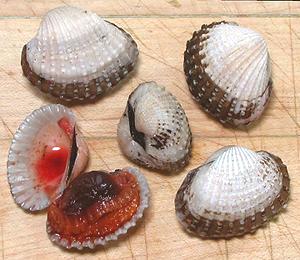 [Sò Huyet (Viet); Kkomak (Korea); Anadara granosa alt
Tegillarca granosa]
[Sò Huyet (Viet); Kkomak (Korea); Anadara granosa alt
Tegillarca granosa]
These clams are native to intertidal zones of the Indo-Pacific region,
from South Africa east to Australia and Polynesia, and as far north as
northern Japan. they are of great economic value and farmed in mud
flats in much of their range. They are sold frozen in Asian markets
whole, half shell, or as cooked frozen meat. The photo specimens were
purchased frozen from a large Asian market in Los Angeles (San
Gabriel) for 2017 US $5.61 / pound - product of Vietnam. They can
get as large as 2.4 inches, but the largest in this batch was 1.4
inches long and 1.1 inches thick. They weighed about 44 to the pound
on average.
As packaged, they were minimally cooked, thus the open one has
the appearance of being raw, and will look much less unappetizing
when cooked a bit more. Edible yield, as removed from the shells was
3.9 ounces / pound (24%), but after a brief boil they dropped to 2.7
ounces / pound (17%) due to loss of liquid. Flavor (after the short
boil) was quite good and clamy, but meatier than most clams of this
size. The red clam juice is not very useful as it turns gray with
cooking.
Safety:
Although traditionally eaten raw, or with
a very short boil (Shanghai), this is risky. Due to their environment
and the amount of water they must filter, they contain more bacteria
and Viri than most clams, and should be coooked reasonably well.
Mexican Blood Clam
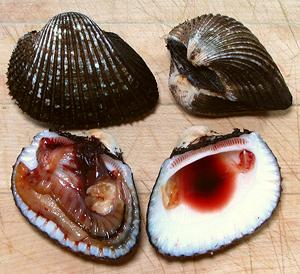 [Concha Negra (Mexico, Peru, Nicaragua, El Salvador); Chucheca
(Panama, Costa Rica); Patas de Mula (Mexico); Concha Prieta
(Panama); Pianga (Colombia, Costa Rica; Anadara tuberculosa]
[Concha Negra (Mexico, Peru, Nicaragua, El Salvador); Chucheca
(Panama, Costa Rica); Patas de Mula (Mexico); Concha Prieta
(Panama); Pianga (Colombia, Costa Rica; Anadara tuberculosa]
These clams are native to intertidal zones of the Eastern Pacific
from Baja Mexico to Peru. They can grow to 3 inches long, but the
photo specimens were up to 2.6 inches long and 1.7 inches thick.
Average weight of the batch was 1.2 ounces each. The open clam in
the photo is raw, and will look much less unappetizing when cooked.
Yield raw was about 18%, and 14% cooked.
The photo specimens were purchased from a live seafood tank at
a large Asian market in Los Angeles (San Gabriel) for 2017 US
$4.69 / pound. They tend to not open when steamed, even for more
than 10 minutes, but pried open, if they smell OK, they are edible.
Safety:
These were illegal to import into the
United States until 2014, when the U.S. and Mexico came to an
agreement on assuring safety of these clams. Blood clams are more
a bacteria and virus risk than most clams because of their environment
and the amount of water they must filter. Personally, I eat them well
steamed rather than raw, though they are often served raw in Mexico
and in some Mexican restaurants in Los Angeles.
Akagai
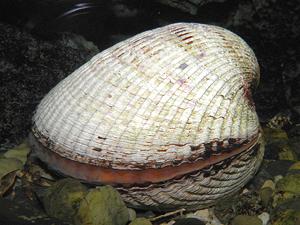 [Inflated Ark; Anadara broughtonii]
[Inflated Ark; Anadara broughtonii]
These clams are native to intertidal zones of the Western Pacific,
south of the northern island of Japan (Hokkaido) down the East
Asian coasts to the Philippines and the Pacific side of Indonesia.
The population is extensive along north central Australia, and some
are found in southern New Zealand. They are similar to the Mexican
Blood Clam, but rounder and even thicker. They are usually prepared
as Sushi or Sashimi. These clams are both fished wild and farmed.
They can grow to nearly 5 inches long, but in aquaculture are usually
harvested at 2 inches and above.
Photo by A. C. Tatarinov contributed to the Public
Domain.
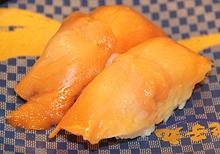 To the left is a typical serving of Akagai over Sushi Rice. The slices
may have been pounded flat to make them large enough to cover the
rice. For sushi, 3 inch long clams are needed.
Photo by Arashiyama distributed under license
Creative Commons
Attribution-ShareAlike 3.0 Unported.
To the left is a typical serving of Akagai over Sushi Rice. The slices
may have been pounded flat to make them large enough to cover the
rice. For sushi, 3 inch long clams are needed.
Photo by Arashiyama distributed under license
Creative Commons
Attribution-ShareAlike 3.0 Unported.
Noah's Ark Shell
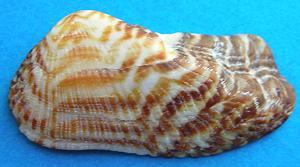 [Arca noae]
[Arca noae]
This Ark Clam is native mostly to the Mediterranean and the coast
of Morocco, but to a lesser extent down the west coast of Africa
with a significant population off the tip of South Africa. I do not
think this Ark Clam is a "blood clam", but, even though it's fished
commercially in the Adriatic Sea (between Italy and the Balkans) and
elsewhere, I can find almost no information about it. These clams
are usually around 4 inches long when mature.
Photo by M.Violante distributed under license
Creative Commons
Attribution-ShareAlike 3.0 Unported.
sf_bvarcz 171213 - www.clovegarden.com
©Andrew Grygus - agryg@clovegaden.com - Photos on this
page not otherwise credited are © cg1 -
Linking to and non-commercial use of this page permitted
 To the left is a typical serving of Akagai over Sushi Rice. The slices
may have been pounded flat to make them large enough to cover the
rice. For sushi, 3 inch long clams are needed.
Photo by Arashiyama distributed under license
Creative Commons
Attribution-ShareAlike 3.0 Unported.
To the left is a typical serving of Akagai over Sushi Rice. The slices
may have been pounded flat to make them large enough to cover the
rice. For sushi, 3 inch long clams are needed.
Photo by Arashiyama distributed under license
Creative Commons
Attribution-ShareAlike 3.0 Unported.
 [Ark Shell; family Arcidae]
[Ark Shell; family Arcidae]
 [Sò Huyet (Viet); Kkomak (Korea); Anadara granosa alt
Tegillarca granosa]
[Sò Huyet (Viet); Kkomak (Korea); Anadara granosa alt
Tegillarca granosa]
 [Concha Negra (Mexico, Peru, Nicaragua, El Salvador); Chucheca
(Panama, Costa Rica); Patas de Mula (Mexico); Concha Prieta
(Panama); Pianga (Colombia, Costa Rica; Anadara tuberculosa]
[Concha Negra (Mexico, Peru, Nicaragua, El Salvador); Chucheca
(Panama, Costa Rica); Patas de Mula (Mexico); Concha Prieta
(Panama); Pianga (Colombia, Costa Rica; Anadara tuberculosa]
 [Inflated Ark; Anadara broughtonii]
[Inflated Ark; Anadara broughtonii]
 [Arca noae]
[Arca noae]